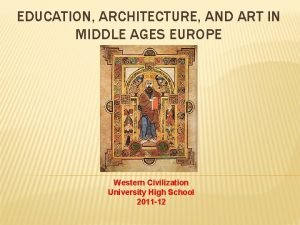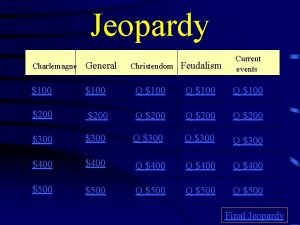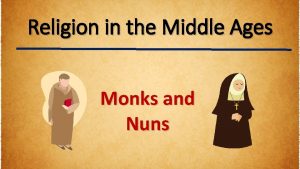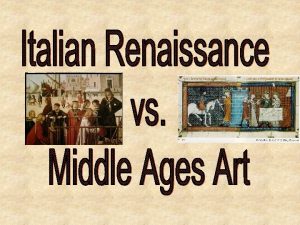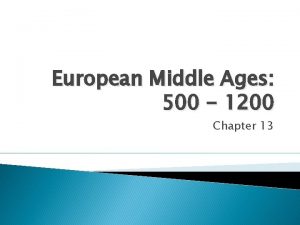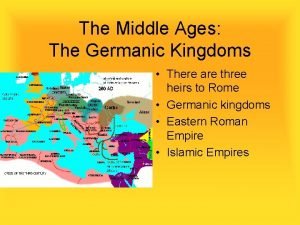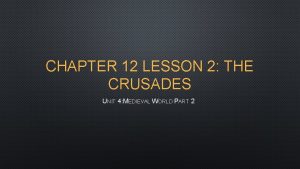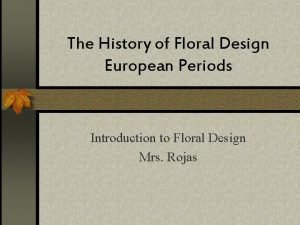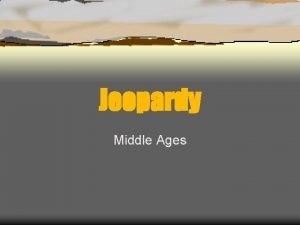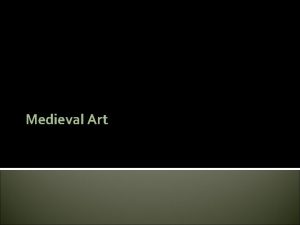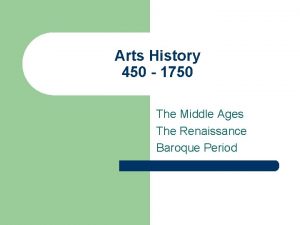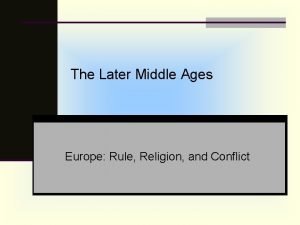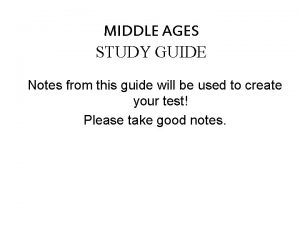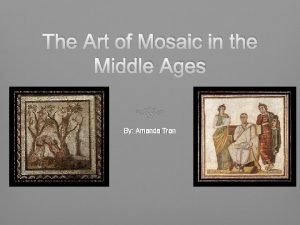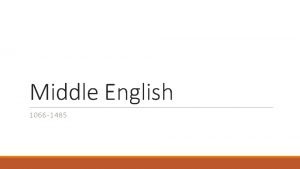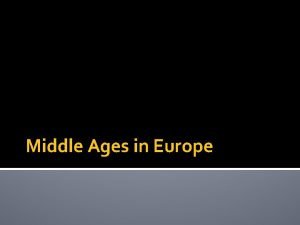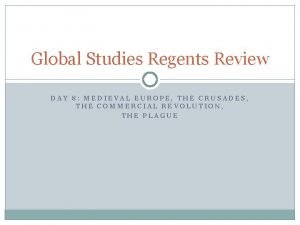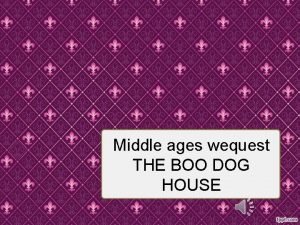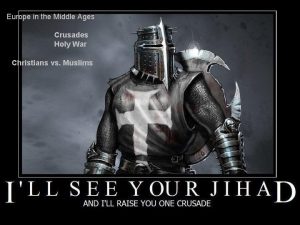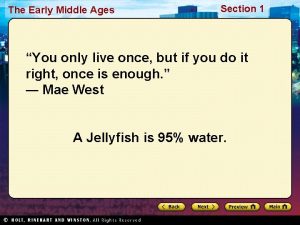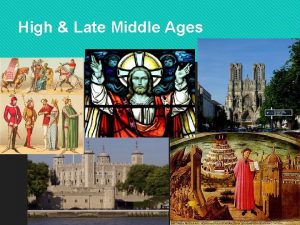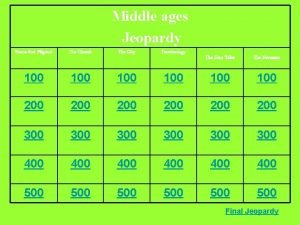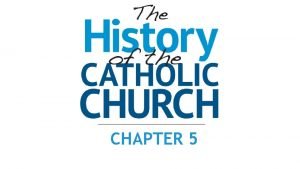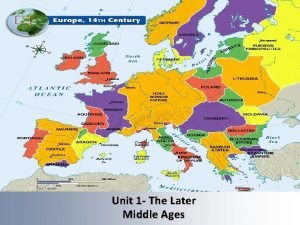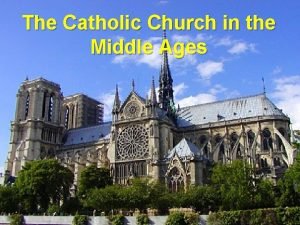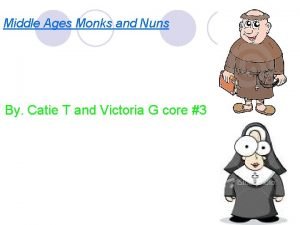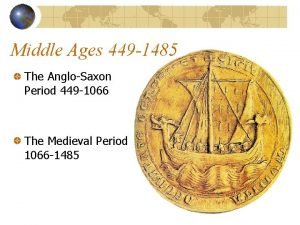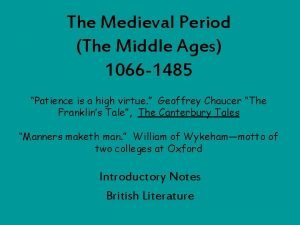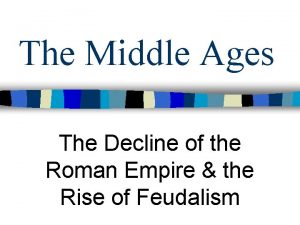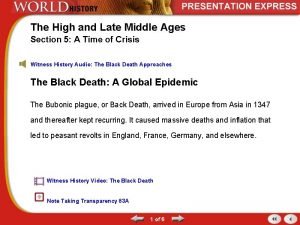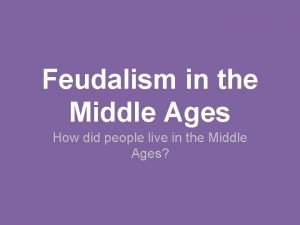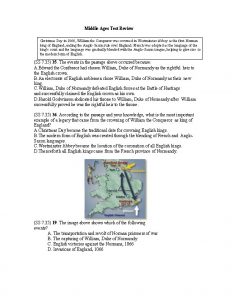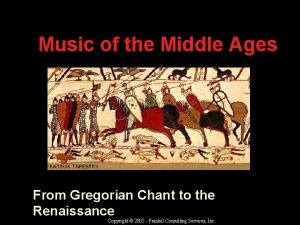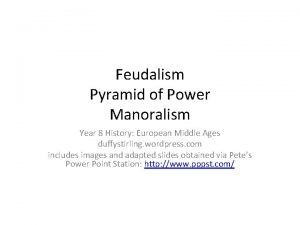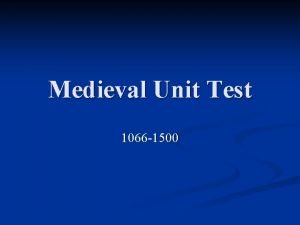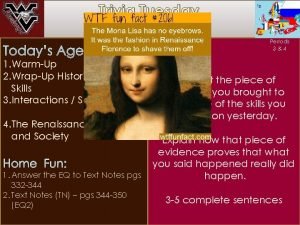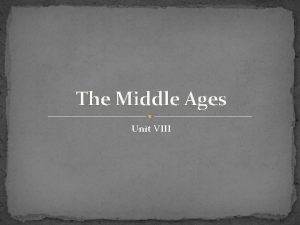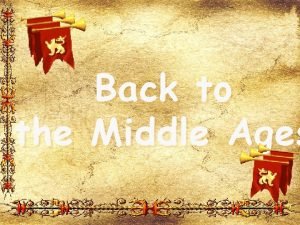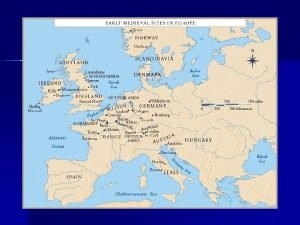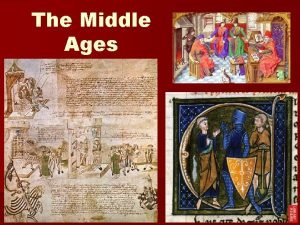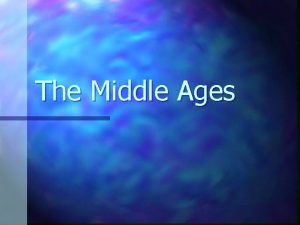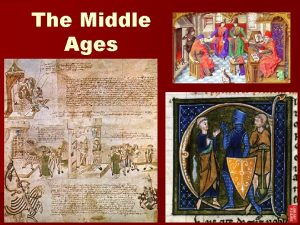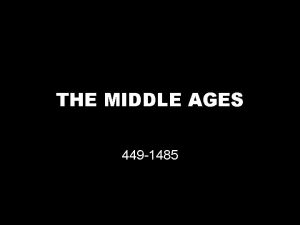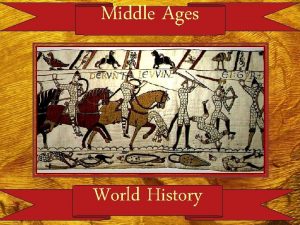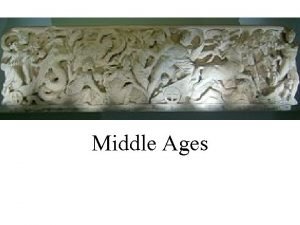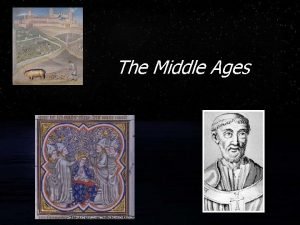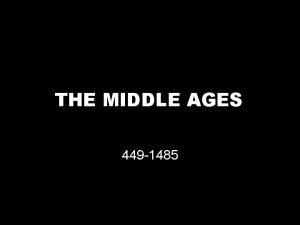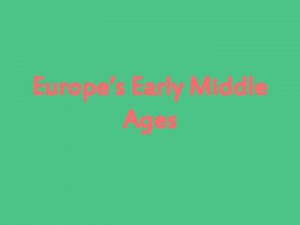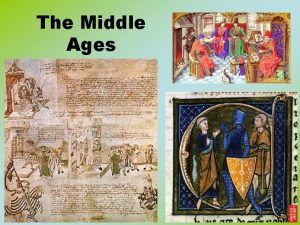Overview of the Middle Ages The MIDDLE AGES

















































- Slides: 49

Overview of the Middle Ages

• The MIDDLE AGES is commonly believed to span from 500 C. E. to 1300 C. E. • The term medieval comes from the LATIN: Middi = MIDDLE and æv= AGES • The MIDDLE AGES was once called Medieval, Dark Ages and Age of Faith

• The Middle Ages spanned over thousands of years. It basically could be divided into three periods: • Early Middle Ages(450 -1000), • High M. A. (1000 -1200) • Late Middle Ages. (1200 -1500)

• The middle ages began in the west with the fall of Rome and the beginning of the Germanic rule. • In the Eastern territories, the Empire of Byzantine (capital city Constantinople) a Christian stronghold, was considered the most stable empire in the Middle Ages. It was a civilized community where learning, art and rules were valued. They spoke Greek, Latin and most other languages.

• The High Middle Ages started in the 11 th century and spanned to the 13 th century. This was the age of the Norman conquests in Britain and Sicily, the earlier Crusades, the Investiture Controversy and the signing of the Magna Carta.

• There was an explosion of stone castlebuilding, and the construction of some of the most magnificent cathedrals in Europe. What we call feudalism today was firmly established in Britain and parts of Europe; trade in luxury items as well as staples flourished; towns were granted charters; and a well-fed population was beginning to grow rapidly.

• The Late Middle Ages can be considered the transformation period. It was a time when the Black Death, preceded by famine and overpopulation, wiped out at least a third of Europe and marked the end of the prosperity that had characterized the high medieval era. • The Church’s influence dwindled.

• Towns and cities were wresting control of their own government from the hands of the church or nobility that had previously ruled them. And the reduction in population triggered economic and political changes that would never be reversed.

Art • The MIDDLE AGES were reflected in a number of Art periods: Celtic, Early Christian, Byzantine, Migration Period, Pre-Romanesque, Gothic and Islamic

• Celtic Art was practiced by the Celtic speaking people of Ireland England during the 5 th to the 12 th centuries C. E. Celtic art is ornamental, avoiding straight lines and only occasionally using symmetry, without the imitation of nature or ideal of beauty central to the classical tradition, but as far as we can understand it often involves complex symbolism.

• Early Christian Art flourished from 200 to 500 C. E. The artist working during this period reflected the Roman/pagan media such as Sculpture, Mosaic, Fresco, and Manuscript Illumination. They also adopted Roman motifs, human proportions and presentation of space.

• Byzantine art overlaps Early Christian art. If the purpose of classical art was the glorification of man, the purpose of Byzantine art was the glorification of God. Dome built on 4 pillars became the Model for all Byzantine churches Hagia Sophia was rebuilt from 532 to 537

• Migration Art is the artwork of the Germanic people during the 300 to 900 C. E. It examines the different types of art including the Polychrome style (colourful) and the Animal style.

• Pre-Romanesque art took place between the 8 th and 12 th centuries C. E. It consisted of the Carolingian art, the Ottonian art and the Anglo-Saxon art as well as the art of France, Italy and Spain.

• The Romanesque art period took place between the 11 th and 12 th centuries C. E. The focus of this art period is Architecture. It is characterized by a use of round or slightly pointed arches, barrel vaults, cruciform piers supporting vaults, and groin vaults.

• The Gothic period took place between mid-12 th and late 15 th centuries C. E. The principle art mediums of this period were sculpture, panel painting, stain glass, fresco and illuminated manuscripts. The Gothic style of architecture in this period emphasized verticality and features almost skeleton stone structures with great expanses of glass, pointed arches using the ogive shape, ribbed vaults, clustered columns, sharply pointed spires, flying buttresses and inventive sculptural detail.

• The Islamic art period took place between 500 and 1500. C. E. This style throughout history has been mainly an abstract and decorative, portraying geometric, floral, Arabesque, and calligraphic designs.

Daily Life in the Medieval Era • For safety and for defense, people in the Middle Ages formed small communities around a central lord or master. Most people lived on a manor, which consisted of the castle, the church, the village, and the surrounding farm land. These manors were isolated, with occasional visits from peddlers, pilgrims on their way to the Crusades, or soldiers from other fiefdoms.

• In this "feudal" system, the king awarded land grants or "fiefs" to his most important nobles, his barons, and his bishops, in return for their contribution of soldiers for the king's armies. •

• At the lowest echelon of society were the peasants, also called "serfs" or "villains. " In exchange for living and working on his land, known as the "demesne, " the lord offered his peasants protection.

• Nobles divided their land among the lesser nobility, who became their servants or "vassals. " Many of these vassals became so powerful that the kings had difficulty controlling them. By 1100, certain barons had castles and courts that rivaled the king's; they could be serious threats if they were not pleased in their dealings with the crown.

• In 1215, the English barons formed an alliance that forced King John to sign the Magna Carta. While it gave no rights to ordinary people, the Magna Carta did limit the king's powers of taxation and require trials before punishment. It was the first time that an English monarch came under the control of the law.

• Peasants worked the land produced the goods that the lord and his manor needed. This exchange was not without hardship for the serfs. They were heavily taxed and were required to relinquish much of what they harvested. The peasants did not even "belong to" themselves, according to medieval law. The lords, in close association with the church, assumed the roles of judges in carrying out the laws of the manor.

• It should come as no surprise that women, whether they were nobles or peasants, held a difficult position in society. They were largely confined to household tasks such as cooking, baking bread, sewing, weaving, and spinning. However, they also hunted for food and fought in battles, learning to use weapons to defend their homes and castles. Some medieval women held other occupations. There women blacksmiths, merchants, and apothecaries. Others were midwives, worked in the fields, or were engaged in creative endeavors such as writing, playing musical instruments, dancing, and painting.

• Some women were known as witches, capable of sorcery and healing. Others became nuns and devoted their lives to God and spiritual matters. Famous women of the Middle Ages include the writer Christine de Pisan; the abbess and musician Hildegard of Bingen; and the patron of the arts Eleanor of Aquitaine. A French peasant's daughter, Joan of Arc, or St. Joan, heard voices telling her to protect France against the English invasion. She dressed in armor and led her troops to victory in the early fifteenth century. "The Maid of Orleans" as she was known, was later burned as a witch.

• The Catholic Church was the only church in Europe during the Middle Ages, and it had its own laws and large coffers. Church leaders such as bishops and archbishops sat on the king's council and played leading roles in government. Bishops, who were often wealthy and came from noble families, ruled over groups of parishes called "diocese. " Parish priests, on the other hand, came from humbler backgrounds and often had little education. The village priest tended to the sick and indigent and, if he was able, taught Latin and the Bible to the youth of the village.

• As the population of Europe expanded in the twelfth century, the churches that had been built in the Roman style with round-arched roofs became too small. Some of the grand cathedrals, strained to their structural limits by their creators' drive to build higher and larger, collapsed within a century or less of their construction.

• Monasteries in the Middle Ages were based on the rules set down by St. Benedict in the sixth century. The monks became known as Benedictines and took vows of poverty, chastity, and obedience to their leaders. They were required to perform manual labor and were forbidden to own property, leave the monastery, or become entangled in the concerns of society. Daily tasks were often carried out in silence. Monks and their female counterparts, nuns, who lived in convents, provided for the less-fortunate members of the community.

• Monasteries and nunneries were safe havens for pilgrims and other travelers.

• Monks went to the monastery church eight times a day in a routine of worship that involved singing, chanting, and reciting prayers from the divine offices and from the service for Mass. The first office, "Matins, " began at 2 A. M. and the next seven followed at regular intervals, culminating in "Vespers" in the evening and "Compline" before the monks retired at night. Between prayers, the monks read or copied religious texts and music. Monks were often well educated and devoted their lives to writing and learning. The Venerable Bede, an English Benedictine monk who was born in the seventh century, wrote histories and books on science and religion.

Pilgrimages • Pilgrimages were an important part of religious life in the Middle Ages. Many people took journeys to visit holy shrines such as the Church of St. James at Santiago de Compostela in Spain, the Canterbury cathedral in England, and sites in Jerusalem and Rome. Chaucer's Canterbury Tales is a series of stories told by 30 pilgrims as they traveled to Canterbury.

Medieval Homes • Most medieval homes were cold, damp, and dark. Sometimes it was warmer and lighter outside the home than within its walls. For security purposes, windows, when they were present, were very small openings with wooden shutters that were closed at night or in bad weather. The small size of the windows allowed those inside to see out, but kept outsiders from looking in.

• Many peasant families ate, slept, and spent time together in very small quarters, rarely more than one or two rooms. The houses had thatched roofs and were easily destroyed.

• The homes of the rich were more elaborate than the peasants' homes. Their floors were paved, as opposed to being strewn with rushes and herbs, and sometimes decorated with tiles. Tapestries were hung on the walls, providing not only decoration but also an extra layer of warmth. Fenestral windows, with lattice frames that were covered in a fabric soaked in resin and tallow, allowed in light, kept out drafts, and could be removed in good weather. Only the wealthy could afford panes of glass; sometimes only churches and royal residences had glass windows.

Food • In simpler homes where there were no chimneys, the medieval kitchen consisted of a stone hearth in the center of the room. This was not only where the cooking took place, but also the source of central heating. In peasant families, the wife did the cooking and baking. The peasant diet consisted of breads, vegetables from their own gardens, dairy products from their own sheep, goats, and cows, and pork from their own livestock. Often the true taste of their meat, salted and used throughout the year, was masked by the addition of herbs, leftover breads, and vegetables.

• Some vegetables, such as cabbages, leeks, and onions became known as "pot-herbs. " This pottage was a staple of the peasant diet. • The kitchens of manor houses and castles had big fireplaces where meat, even large oxen, could be roasted on spits. These kitchens were usually in separate buildings, to minimize threat of fire. Pantries were hung with birds and beasts, including swans, blackbirds, ducks, pigeons, rabbits, mutton, venison, and wild boar. Many of these animals were caught on hunts.

Garbage • Current archaeological studies of sewage and rubbish pits contribute to our understanding of what medieval people ate. One of the most informative pits was found in Southampton, England. This pit belonged to a prominent merchant. It contained the remains of berries, fruits, and nuts, as well as pottery, glass, and fabrics, including silk, from Europe and the Near East. It also contained the remains of a Barbary ape. Documents found at the site describe the family's consumption of meat, use of pewter utensils, and love of music. Evidence that butchery took place during this time was also found in these documents

Clothing • Most people in the Middles Ages wore woolen clothing, with undergarments made of linen. • Brighter colors, better materials, and a longer jacket length were usually signs of greater wealth. The clothing of the aristocracy and wealthy merchants tended to be elaborate and changed according to the dictates of fashion. • Towards the end of the Middle Ages, men of the wealthy classes sported hose and a jacket, often with pleating or skirting, or a tunic with a surcoat.

• Women wore flowing gowns and elaborate headwear, ranging from headdresses shaped like hearts or butterflies to tall steeple caps and Italian turbans. • Fur was often used to line the garments of the wealthy. Jewellery was lavish, by the midfourteenth century there were laws to control who wore what jewellery , and knights were not permitted to wear rings. Sometimes clothes were garnished with silver, but only the wealthy could wear such items.

• Most of the holy orders wore long woolen habits in emulation of Roman clothing. One could tell the order by the color of the habit: the Benedictines wore black; the Cistercians, undyed wool or white. St. Benedict stated that a monk's clothes should be plain but comfortable and they were allowed to wear linen coifs to keep their heads warm. The Poor Clare Sisters, an order of Franciscan nuns, had to petition the Pope in order to be permitted to wear woolen socks.

• Peasant men wore stockings or tunics, while women wore long gowns with sleeveless tunics and wimples to cover their hair. Sheepskin cloaks and woolen hats and mittens were worn in winter for protection from the cold and rain. • Leather boots were covered with wooden patens to keep the feet dry. The outer clothes were almost never laundered, but the linen underwear was regularly washed. The smell of wood smoke that permeated the clothing seemed to act as a deodorant. Peasant women spun wool into the threads that were woven into the cloth for these garments.

Medicine • As the populations of medieval towns and cities increased, hygienic conditions worsened, leading to a vast array of health problems. Medical knowledge was limited and, despite the efforts of medical practitioners and public and religious institutions to institute regulations, medieval Europe did not have an adequate health care system. Antibiotics weren't invented until the 1800 s and it was almost impossible to cure diseases without them. • There were many myths and superstitions about health and hygiene as there still are today. People believed, for example, that disease was spread by bad odours. It was also assumed that diseases of the body resulted from sins of the soul. Many people sought relief from their ills through meditation, prayer, pilgrimages, and other nonmedical methods.

• Medicine was often a risky business. Bloodletting was a popular method of restoring a patient's health and "humours. " Early surgery, often done by barbers without anaesthesia, must have been excruciating. • Medical treatment was available mainly to the wealthy, and those living in villages rarely had the help of doctors, who practiced mostly in the cities and courts. Remedies were often herbal in nature, but also included ground earthworms, urine, and animal excrement.

Art and Music • Art and music were critical aspects of medieval religious life and, towards the end of the Middle Ages, secular life as well. Singing without instrumental accompaniment was an essential part of church services. Monks and priests chanted the divine offices and the mass daily. • Medieval drama grew out of the liturgy, beginning in about the eleventh century. Some of the topics were from the Old Testament (Noah and the flood, Jonah and the whale, Daniel in the lion's den) and others were stories about the birth and death of Christ. These dramas were performed with costumes and musical instruments and at first took place directly outside the church. Later they were staged in marketplaces, where they were produced by local guilds.

Urban Living • Following 1000, peace and order grew. As a result, peasants began to expand their farms and villages further into the countryside. The earliest merchants were peddlers who went from village to village selling their goods. As the demand for goods increased--particularly for the gems, silks, and other luxuries from Genoa and Venice, the ports of Italy that traded with the East--the peddlers became more familiar with complex issues of trade, commerce, accounting, and contracts. They became savvy businessmen and learned to deal with Italian moneylenders and bankers. The English, Belgians, Germans, and Dutch took their coal, timber, wood, iron, copper, and lead to the south and came back with luxury items such as wine and olive oil. • With the advent of trade and commerce, feudal life declined. As the tradesmen became wealthier, they resented having to give their profits to their lords. Arrangements were made for the townspeople to pay a fixed annual sum to the lord or king and gain independence for their town as a "borough" with the power to govern itself. The marketplace became the focus of many towns.

Forming Town Governments • As the townspeople became "free" citizens, powerful families, particularly in Italy, struggled to gain control of the communes or boroughs. Town councils were formed. Guilds were established to gain higher wages for their members and protect them from competitors. As the guilds grew rich and powerful, they built guildhalls and began taking an active role in civic affairs, setting up courts to settle disputes and punish wrongdoers.

• The new merchant class included artisans, masons, armourers, bakers, shoemakers, rope makers, dyers, and other skilled workers. Of all the craftsmen, the masons were the highest paid and most respected. They were, after all, responsible for building the cathedrals, hospitals, universities, castles, and guildhalls. They learned their craft as apprentices to a master mason, living at lodges for up to seven years.

• The population of cities swelled for the first time since before the Dark Ages. With the new merchant activity, companies were formed. Merchants hired bookkeepers, scribes, and clerks, creating new jobs. • Printing began in 1450 with the publication of the Bible by Johannes Gutenberg. This revolutionized the spread of learning. Other inventions of the time included mechanical clocks, tower mills, and guns. The inventions of Leonardo da Vinci and the voyages of discovery in the fifteenth century contributed to the birth of the Renaissance. • Few serfs were left in Europe by the end of the Middle Ages, and the growing burgher class became very powerful. Hard work and enterprise led to economic prosperity and a new social order. Urban life brought with it a new freedom for individuals.

 Dark ages vs middle ages
Dark ages vs middle ages Renaissance vs medieval art
Renaissance vs medieval art Cathedral art
Cathedral art Middle ages jeopardy
Middle ages jeopardy Naissance renaissance
Naissance renaissance Monks and nuns in the middle ages
Monks and nuns in the middle ages Dark ages vs renaissance
Dark ages vs renaissance Eleanor of aquitine
Eleanor of aquitine Germanic kingdoms
Germanic kingdoms Chapter 12 lesson 4 the late middle ages
Chapter 12 lesson 4 the late middle ages European floral design history
European floral design history Middle ages jeopardy
Middle ages jeopardy Medieval art characteristics
Medieval art characteristics Musical representation of specific poetic images
Musical representation of specific poetic images Early middle ages
Early middle ages Middle ages study guide answer key
Middle ages study guide answer key Mosaic middle ages
Mosaic middle ages Early american period floral design
Early american period floral design Mean
Mean High middle ages
High middle ages The middle ages 1066 to 1485 unit introduction
The middle ages 1066 to 1485 unit introduction Manorialism def
Manorialism def The middle ages outcome the power of the church
The middle ages outcome the power of the church Art in emerging europe summary
Art in emerging europe summary History of floral design crossword
History of floral design crossword Middle ages regents questions
Middle ages regents questions During the middle ages noblewomen had
During the middle ages noblewomen had Middle ages
Middle ages Middle ages nobles
Middle ages nobles High to late middle ages
High to late middle ages Language answer
Language answer Late middle ages timeline
Late middle ages timeline Similarities between middle ages and renaissance
Similarities between middle ages and renaissance European middle ages map
European middle ages map Middle ages
Middle ages Monks and nuns in the middle ages
Monks and nuns in the middle ages Middle ages
Middle ages A metaphorical phrase used to replace a concrete noun
A metaphorical phrase used to replace a concrete noun Middle english period (1066-1500)
Middle english period (1066-1500) Middle ages
Middle ages The high and late middle ages section 5 quiz
The high and late middle ages section 5 quiz Feudal system in the middle ages
Feudal system in the middle ages Middle ages test review
Middle ages test review How is this
How is this Sacred music of the middle ages
Sacred music of the middle ages Gregorian chant middle ages
Gregorian chant middle ages Feudal system pyramid of power
Feudal system pyramid of power Middle ages unit test answers
Middle ages unit test answers Renaissance vs middle ages
Renaissance vs middle ages Middle ages def
Middle ages def


